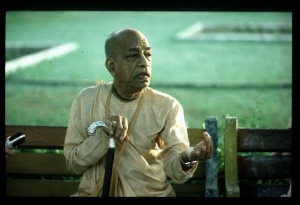CC Adi 10.62 (1975)

A.C. Bhaktivedanta Swami Prabhupada
Below is the 1996 edition text, ready to be substituted with the 1975 one using the compile form.
TEXT 62
- caitanya-dāsa, rāmadāsa, āra karṇapūra
- tina putra śivānandera prabhura bhakta-śūra
SYNONYMS
caitanya-dāsa—Caitanya dāsa; rāmadāsa—Rāmadāsa; āra—and; karṇapūra—Karṇapūra; tina putra—three sons; śivānandera—of Śivānanda Sena; prabhura—of the Lord; bhakta-śūra—of the heroic devotees.
TRANSLATION
The three sons of Śivānanda Sena, named Caitanya dāsa, Rāmadāsa and Karṇapūra, were all heroic devotees of Lord Caitanya.
PURPORT
Caitanya dāsa, the eldest son of Śivānanda Sena, wrote a commentary on Kṛṣṇa-karṇāmṛta that was later translated by Śrīla Bhaktivinoda Ṭhākura in his paper Sajjana-toṣaṇī. According to expert opinion, Caitanya dāsa was the author of the book Caitanya-carita (also known as Caitanya-caritāmṛta), which was written in Sanskrit. The author was not Kavi-karṇapūra, as is generally supposed. This is the opinion of Śrīla Bhaktisiddhānta Sarasvatī Ṭhākura. Śrī Rāmadāsa was the second son of Śivānanda Sena. It is stated in the Gaura-gaṇoddeśa-dīpikā (145) that the two famous parrots named Dakṣa and Vicakṣaṇa in kṛṣṇa-līlā became the elder brothers of Kavi-karṇapūra, namely Caitanya dāsa and Rāmadāsa. Karṇapūra, the third son, who was also known as Paramānanda dāsa or Purī dāsa, was initiated by Śrīnātha Paṇḍita, who was a disciple of Śrī Advaita Prabhu. Karṇapūra wrote many books that are important in Vaiṣṇava literature, such as the Ānanda-vṛndāvana-campū, Alaṅkāra-kaustubha, Gaura-gaṇoddeśa-dīpikā and the great epic Caitanya-candrodaya-nāṭaka. He was born in the year 1448 Śakābda (A.D. 1526). He continually wrote books for ten years, from 1488 until 1498.